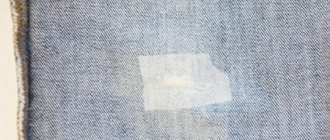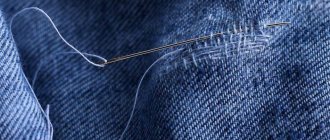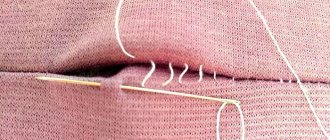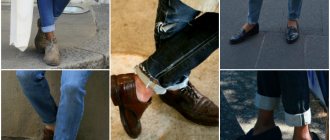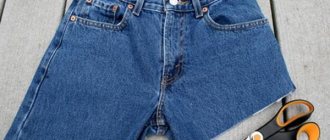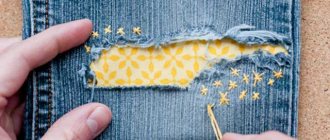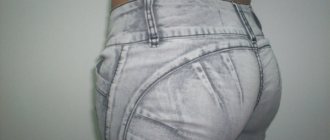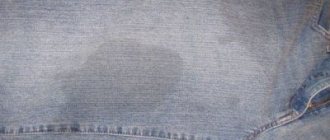In what places do jeans tear and fray more often?
The reason for damage to the fabric can be its disrepair. With prolonged wear, abrasions inevitably appear on clothes. Over time, the fibers can become so thin that they begin to tear, creating a hole. Jeans also become unusable as a result of mechanical damage. A person may fall, get caught on a nail, or accidentally burn through the material.
Abrasions as a result of long-term use most often form in the following places:
- between the legs;
- along the bottom edge of the trouser legs;
- along the edges of the front pockets;
- on the knees.
Holes and tears from mechanical damage often appear on the knees, on back pockets, and near the edges of pockets.
How to sew jeans up discreetly without a sewing machine?
There are several ways to repair jeans without using a sewing machine. Each of them is selected depending on the specific location to be repaired, as well as the shape and size of the damage.
Darn
This type of clothing repair involves replacing worn threads of fabric with new ones. Therefore, for high-quality, accurate repair of garments, threads are selected that are most suitable in color, thickness and texture. The best option would be to use threads from the same jeans that are subject to darning. They can be carefully removed from the folded bottom of the trousers or other inconspicuous place.
If this is not possible, take special threads for darning or floss.
How to sew up a hole in jeans.
One option is darning. Darning is suitable for restoring heavily worn fabric that begins to “glow”. Most often, such injuries appear between the legs, as a result of friction when walking. You can also mend a small hole with torn edges. In this case, a patch is placed on the wrong side, which is sewn along the edges or glued with an iron.
Plastering
In cases where it is necessary to seamlessly connect the edges of the fabric, a piece is used. This repair option is suitable if the jeans were cut by something sharp or torn by a nail. Using the same method, you can seal a through hole that has a round or irregular shape.
Plastering is the most common technique when repairing jeans. There are several types of gizmo that can eliminate most of the most common damage to denim.
Examples:
- Vertical stitching.
- Laying stitches horizontally.
- Stitching diagonally.
- Close seam over edge stitched edges.
- Piecing thick fabric from front to back without piercing the fabric through.
Blind seam
You can sew jeans up discreetly by hand using a hidden seam. This method is usually used if the trousers are ripped at the seam. For example, the seam may come apart on the buttocks or sides. There are often cases when some sewn part comes off: a belt or a patch pocket.
If this is the only defect that is not accompanied by scuffs and dilapidation of the canvas itself, then a hidden seam will help completely eliminate the damage without leaving any traces of repair.
This technique is also used in cases where it is necessary to hem the bottom of the trouser legs. The need for this action may arise for various reasons: restoring frayed edges, securing the hem on the wrong side, or processing the bottom after shortening the jeans.
Features of jeans repair
In some cases, jeans at the knee can be repaired under warranty if no more than two weeks have passed since the date of purchase. But most often the seller simply exchanges the item for a new one. Unfortunately, not all clothing brands provide warranty service. If the defect did not arise due to a manufacturing defect, you will have to sew up the hole yourself.
To fix jeans at the knee, you need to study the characteristics of the material. Any seams on it will be very noticeable. Therefore, you will have to work hard if you need to disguise them.
To sew everything correctly, it is advisable to follow the following recommendations:
- threads are chosen as close as possible to the color of the jeans;
- machine stitches must be made perpendicular to the gap;
- dense pieces are applied to large holes, and sparse ones are applied to small ones.
- After darning, it is necessary to strengthen the seam.
Comment! Before attaching a patch or applique with threads, it is advisable to hook it with pins and see how organic it will look.
How to sew women's jeans at the knee
To properly sew up torn jeans at the knees, it is advisable to familiarize yourself with the process in the photo. This will not cause any particular difficulties even for those who have never sewed. The most suitable way to mend jeans at the knee involves using patch material. It is applied to the hole from the wrong side. You can find it at any sewing supply store. A small piece of old jeans is also often used as a patch. But it must match in color. A creative method of solving a problem involves applying an application.
Plastering can be done either using a machine or manually. The main thing to sew up a hole is to follow the following algorithm:
- Threads are selected to match the lining material.
- A piece of material is applied and fixed to the problem area using an iron. In this case, it is advisable to use a mode designed for ironing cotton fabric.
- If regular fabric rather than denim is used as a patch, it should be basted first.
- The sewing machine is threaded with needles and threads to match the jeans. The lines are made in the form of a zigzag, using backward and forward strokes. The resulting seams should be located perpendicular to the hole.
- After the patch is securely fixed, the basted threads are removed with scissors.
Recommended reading: How to get rid of paint smell in an apartment
Girls who want to keep up with the times can use a fashionable life hack. Masking with threads of a contrasting color will help to sew up a hole in jeans at the knee. To do this, you will need a sewing machine with a forward-backward function. Darning is carried out in several layers until the hole is completely covered. This method is only suitable if the hole in the jeans is very small.
How to sew men's jeans at the knee
Not all men like frayed and torn jeans. Many of them prefer the usual classics in clothes. In this case, the repair of the item must be carried out as discreetly as possible. The result depends on how big the hole is. If the hole is small, you can sew the jeans at the knee by hand. A photo of the process will help you understand the suture pattern. It is important to follow the following rules:
- To make the stitching even, the material should be stretched as much as possible;
- the seam should run parallel to the threads in the fabric so that it matches its structure;
- if you don’t have the right color of thread at hand, you should select the two closest in tone and insert them into the needle together;
- a tiny hole can be masked using the plastering method.
You can sew up a hole by covering it with appliqué. On men's clothing, leather inserts are often used for this purpose. They look quite interesting and do not attract unnecessary attention. But it is advisable to sew the skin to the hole in the knee using a machine. When sewing by hand, there is a risk of damaging the fabric.
How to sew children's jeans at the knee
Patches on children's jeans on the knee are much easier to make. This is due to the absence of the need to adapt to a certain style of clothing. You can resort to using applications. For a child, masking a hole in this way will be comparable to purchasing a new thing.
The design for the applique is cut out from old clothes or made yourself. In the latter case, a huge scope for creativity opens up. Coins, fringe, sequins and ribbons can be used as decorative elements. First you need to design the application. Only after this can you start decorating the jeans.
The patch is applied to the problem area. Its diameter should exceed the size of the hole by 1 cm. If adhesive tape is used for decoration, it must first be smoothed to the material with an iron. On the sewing machine panel, select a zigzag type of seam. The process of stitching the fabric must be carried out tightly.
There is another way to patch jeans on the knee. To do this you will need a thermal adhesive. It is easy to find in any specialty store. It is applied to the patch. In this case, the seams will be completely invisible.
You can sew jeans at the knee by hand without a seam. This stitching technique is called “sashiko”. It took its distribution from Japan. A characteristic feature of the technique is making multiple punctures in the tissue with a contrast thread inserted into them. For decoration you will need a specialized thread or floss. Any scrap of old clothing is used as a patch. It may not be in harmony in its texture and pattern with jeans. Since the method is quite traumatic, you will also need a thimble.
Pieces of material are cut out with a diameter 3 cm larger than the hole in the jeans. It is applied to the hole from the wrong side. It is important to check that the fabric is not stretched, as the leg will bend at the knee. The piece of fabric is fixed in the desired place using a large number of pins. Using a marker, draw a suitable pattern in the knee area. The abundance of options is limited only by imagination. Short stitches are made on the front side, and long stitches on the back side. To play up the design, you can sew the same piece of fabric as in the patch onto one of the legs.
Attention! For artistic darning on denim, it is advisable to acquire a special marker, with which you can schematically outline the future design.
Technique for manually sealing a round hole
To seal a round through hole, you need to prepare the following tools and materials:
- a piece of denim fabric of the same color as the item being repaired;
- threads matching the color;
- needle;
- scissors;
- iron.
Work to eliminate the hole is carried out in the following order:
- Cut a patch from the flap that is larger in diameter than the hole.
- Place the patch with the front side to the wrong side of the jeans and sew around the circumference with a small seam, no more than 1 mm on the front side. If possible, you should try not to pierce the fabric all the way through, but rather grab individual threads from the surface of the wrong side.
- Place the holey area with the sewn patch on a hard surface, slightly stretching the fabric. In this case, the front side of the jeans should be located on top, and the patch on the bottom.
- On the front side of the hole, make frequent parallel stitches along the grain thread. The needle entry and exit points should be at some distance from the edge of the hole, into undamaged areas of the material. To avoid the edges bunching up, make a small loop at the end of each row.
- After the entire hole is closed with long longitudinal stitches, the same stitches should be laid in the transverse direction, intertwining them with the threads of the first row.
- It is necessary to take into account the direction of weaving of threads on the restored fabric. When weaving diagonally, the stitches should also be laid diagonally.
- After completing the repair, iron the repaired area first from the wrong side and then from the front side.
Japanese technique "Boro"
The technique originated in the Middle Ages in the Land of the Rising Sun. Boro art consists of numerous parallel stitches of equal length, hand-crafted. They resemble darning with coarse threads. For ease of use, needlewomen advise using long needles.
- To repair damage to jeans, choose thin denim, cotton or linen fabric.
- To work, choose a flap of any shape. The seam allowance should be 3-4 cm.
- Finish the outline of the cut or hole with forward stitches using a needle. In this case, the damage will not stretch further.
- Parallel to the outline of the hole, use a washable felt-tip pen to draw parallel lines for future embroidery. The distance between them can be 0.6-0.8 cm.
- From the wrong side, baste the prepared patch.
- Apply smooth stitches along the marked lines, which should be longer on the front side than on the back side.
- You need to turn the stitch onto the next row from the wrong side. Continue embroidering in the opposite direction.
- Make several rows of stitches on the bottom and top of the patch of different lengths, as well as on the sides.
The cuts on the flap can be slightly frayed if the flap is sewn on the front side of the product. To add style to the patch, you need to choose different stitch lengths and thread colors.
Video about Boro technique
Technique for closing a hole at an angle
It is possible to sew up jeans inconspicuously by hand for various types of damage by selecting the appropriate restoration technique.
For example, for complex angular ruptures, repairs are carried out as follows:
- Place the damaged area on a hard surface.
- Carefully iron the wrong side of the tear.
- Tighten the edges with a thin basting thread. Start with the shorter side of the corner, then sew the second, longer side.
- Each direction of the tear is sewn together with a “needle by needle” suture, starting, as in the previous operation, from a shorter line.
- Sew the treated sides of the corner with an “over the edge” seam.
- Iron through a damp cloth.
Technique for filling a burnt hole
A hole burned by a cigarette or a spark from an open fire source is usually not large in size, has a round shape and characteristic dark scorch marks along the edges. The repair method should be chosen based on these features. The sealing of round holes was discussed above.
However, if the hole is very small and does not exceed 2 - 3 mm in diameter, it can be carefully sewn up with thick threads, pulling the edges together. If the seal is carried out using the method described above, the scorched edges of the hole should first be treated. The scorch marks are cut with scissors, and then the edge of the hole is folded over to the wrong side and hemmed.
Method 1. Sew up the hole with a hidden seam
Below in the picture you can see how to sew two edges, and then by pulling the end thread the seam will hide inside and that’s all.
This method can also be used to sew in larger clothes.
Technique for closing a gap without a patch
A patch will not be needed if a blind stitch is used for the repair. To create a neat and invisible blind seam, you will need to follow the steps described below sequentially.
Technique:
- Insert a needle and thread randomly into the fabric from the reverse side and bring it out onto the face, leaving a knot in the fold of the fabric on the reverse side.
- Connect the edges of the tear by inserting the needle at a distance of 4 - 5 mm from the edge.
- Make a straight stitch, bringing the needle and thread to the front side.
- Repeat this action until the break line is completely closed. While working, the thread should be slightly tightened after each stitch.
- At the end of the work, secure the thread by threading it through the loop and tightening it slightly.
How to manually sew a hole between your legs?
Holes and severe abrasions in the crotch area of jeans are the most common damage that occurs during the use of the item. To repair the damage, you need to cut a patch from the same fabric as the jeans. You can use the bottom of the trouser legs left after shortening.
If this is not possible, the most suitable fabric in color and density is selected. The patch is sewn to the trousers turned inside out. The color of the threads is also selected to match the fabric. The direction of the grain threads on the patch and jeans should match.
From the front side, the sealed area is stitched in a zigzag manner in the forward-backward direction. This technique and compliance with all the nuances allows you to make the damage almost invisible.
If you don't have a machine at hand
Coping with the task manually is somewhat more difficult. You will have to be patient and persevering. The scheme for mending jeans without a machine is as follows:
- We use a patch of dublerin to solder the edges of the hole. We apply it to the wrong side, and go through the front part with a hot iron. As an alternative, you can use a piece of regular fabric - ideally denim in the same color, but any other color will do. The flap is basted around the hole. The torn edges are also tightened with a basting stitch.
- The most important and time-consuming stage is sewing the leaky area with stitches manually. A hand-stitched stitch is as close as possible to a machine stitch. It looks like this:
- You need to make stitches as close to each other as possible using threads of the same color as the jeans.
- In the end, all that remains is to remove the basting stitch.
If the hole or abrasion on the jeans has a large radius, it is necessary to replace the fabric by inserting a flap. There is one trick - you can take the same material from the back pocket area. You need to carefully cut out the part adjacent to the body, and stitch the pocket itself. Instead, it will turn out to be a decoy. Next, the patch is sewn around the perimeter with perpendicular frequent lines.
How to sew up a hole in the butt by hand?
The choice of method for restoring jeans in the buttock area depends on the nature of the damage. A hole with torn edges can be repaired using the plastering method described earlier. Since the defect may be in a fairly noticeable place that catches the eye, it is better not to sew the patch on the wrong side, but to attach it using an adhesive base. This will help avoid possible protruding tissue thickenings.
If your jeans are split along the seam or torn along the seam, you should use a blind seam.
Finally, a hole in the butt can be decorated with an applique or a false pocket. When choosing decorative elements, it is important to observe moderation and focus on the age, gender and lifestyle of the person who will wear the item.
Common mistakes
When working with denim, some mistakes are often made that you can try to avoid:
- when it is said that you need to match the threads to the color, this is what is meant. Even a slightly different tone over large sections can give the piece a cheap and artisanal look;
- the use of patches should be careful, do not think that it doesn’t matter how the fabric gathers under it. The puffy places will also be visible under the appliqué, and folds will form;
- When choosing a replacement button, the easiest way is to focus on the diameter of the old one. Otherwise, you will have to trim or sew up the loop on your jeans belt;
- Some seamstresses are lazy and do not shorten the zipper if it is a few cm longer than required. The extra piece will interfere with wearing and stitching. Therefore, before sewing in the lock, it must be shortened.
The final result depends on the accuracy, diligence and imagination of the owner. But in general, all of the above repair and remodeling methods are simple and only require attention during the process.
How to sew up a hole in your knee with your hands?
It will not be possible to sew jeans at the knee without it being noticeable. However, for lovers of handmade work, in this case there are many opportunities to show creative imagination.
Below are some of the most obvious options for decorating a hole in the knee:
- Denim patch in contrasting color.
- A patch made of printed fabric of a different type and texture.
- Contrasting decorative darning.
- Application.
- Leather patch.
Decorative patches can be sewn on the front side or peeking out from the gap on the back. They can be done on both knees, placed symmetrically, or on just one.
How to mend jeans between the legs using a machine
Holes between the legs are one of the most common problems with pants. It is in these places that the maximum friction of the trouser legs occurs, which is the main reason for the appearance of tears. As you already know: you can darn using a machine or by hand. The manual option has already been considered, so it is worth examining in detail the process of darning with a machine.
Invisible stitching
To do this you need:
- Set the “Straight stitch” mode on the machine;
- Next, the fabric should be compacted by tightly pressing the edges of the material to each other and making parallel lines using a foot;
- Steam the darning area so that it becomes almost invisible to the human eye.
Darning foot
Large holes cannot be sewn up this way, but if the fabric has just begun to unravel, this will help it maintain its appearance and gain additional density in this place.
You might be interested in How measurements are taken for sewing men's trousers and clothing
Application on the knee
How to sew up a hole in a pocket?
Concealing holes in jeans pockets is probably easier than in any other place. Pockets are traditionally decorated with stitching, embroidery, appliques, and stripes.
A small hole can be hidden by sewing an applique on top of it or embroidering any image using satin stitch, woolen or silk floss threads. A contrasting or monochrome artistic darning laid over the patch will perfectly hide the hole.
Embroidery and artistic darning
Embroidery can hide imperfections such as small holes or stains on the fabric. For this procedure, floss threads are used. Drawing a sketch is possible in several ways:
- using a carbon copy;
- washable marker;
- the sketch is applied to non-woven fabric, cut out and attached to the required location;
- application of the overlay canvas - after the process is completed, it is pulled out of the embroidery.
Darning is a real art and is difficult for a beginner to do. Its essence is that damaged fabric is restored using skillfully selected threads or they are taken from an inconspicuous area of the jeans. This operation is performed manually.
But artistic darning can also be done on modern sewing machines. A special material, like canvas, is applied to the hole in the fabric, and embroidery will be applied on top of it. This may require certain skills.
How to sew near a pocket?
The characteristic holes in the corners of the pockets are formed when the pockets are constantly pulled down. This happens when you constantly carry any bulky items in your pockets (for example, a wallet or keys). If a person is used to keeping his hands in his pockets, they can also begin to wear out and tear quite quickly.
The method of sealing holes near the pockets depends on their size. If the hole is barely visible and is located close to the edge of the pocket, it can be sewn with an “over the edge” seam. If there are larger holes, the edge of the pocket should be torn off. Then the hole is darned or stitched in the usual way, after which the pocket is returned to its place.
What to do with the frayed bottom of jeans?
The worn-out bottom of the trousers should be repaired in the following sequence:
- iron the hems;
- cut off frayed threads and/or the entire bottom edge with scissors if it is very frayed;
- sew a trouser tape of a suitable color to the front side;
- wrap the ribbon inward and sew on the wrong side;
- iron with a hot iron;
- if desired, add a finishing stitch.
You can also get rid of frayed bottoms in another way: cut off the trouser legs completely or halfway, turning the jeans into shorts or breeches.
Conversion into shorts
If the bottom of the legs or knees are so hopelessly damaged that it is not possible to repair the jeans, you can turn them into shorts. Before trimming, the item needs to be washed, this will protect its owner from an unpleasant surprise - shrinkage. The process is no different from regular hemming of jeans. The difference is in the number of centimeters cut off.
If you plan to have fringe at the bottom of the shorts, then you need to add a couple of cm to the selected length.
Options for decorating holes (lace, fabric, leather, embroidery, etc.)
Hand-stitching your jeans discreetly isn't always the best idea for a repair. As mentioned above, holes that spoil the appearance of a thing can be “played up” and turned into a fashionable exclusive highlight.
Decor options entirely depend on the taste, preferences, skills and creative courage of the master.
To transform jeans, combining the functions of repair and decoration, almost any materials, decor and accessories are suitable:
- lace;
- textile;
- leather;
- embroidery threads;
- applique;
- rhinestones;
- sequins;
- beads;
- beads.
Large holes on the knees or pockets of women's jeans can be decorated with lace or guipure. If the lace insert is supposed to be on the front side, then the threads should match its color. If the lace is sewn from the wrong side, the threads are matched to the color of the denim. An almost universal way to repair children's or teenagers' jeans is appliqué.
It can be sewn on or in the form of a thermal sticker. A single appliqué can be used to mask a hole in a pocket or knee. However, you can sew many similar decorative elements of various shapes and sizes onto different areas of the trousers. An item decorated in this way will look fun and bold; will allow the teenager to stand out among his peers, which is very important at this age.
Below are options for various creative patch ideas for different damage locations.
| Material and idea | Patch location |
| Embroidery in the form of a monster with a mouth in place of the hole. | Knees, back pockets. |
| The patch is a flower made of fabric with a bead in the core. | Any part of the front of the trouser leg from top to bottom. |
| The patch is a heart made of printed fabric, sewn on the reverse side. | Front leg, back pockets. |
| Embroidery in the shape of an animal's head using satin stitch. | Near any pockets: the animal seems to be peeking out of the pocket. |
How to hand sew or glue a patch?
Methods for sewing patches without using a sewing machine were discussed above.
There are several types of patches used to restore jeans:
- invoice;
- plug-in;
- double-sided;
- decorative
The patch can not only be sewn on, but also glued using non-woven fabric.
If you don’t have adhesive fabric at hand, you can resort to another method of gluing the patch using:
- shoe glue;
- means for gluing rhinestones;
- rubber glue;
- furniture glue;
- glue for layer-by-layer gluing of fabric.
If your jeans are too worn out and can't be repaired, don't throw them away. The fabric can be used to hand-repair other items by cutting out patches or pulling out matching threads.
Hemming and tapering
Fashion changes rapidly, so giving new life to an outdated pair of jeans is a great and practical idea. Short and skinny jeans are in fashion now. First, the length is cut off, then the width of the legs is sewn in.
To hem jeans to any length, you need to put on your shoes and tuck the leg to the desired length, then mark the fabric with chalk. After taking off your jeans, you will need to measure this distance with a centimeter tape and then use a ruler to repeat this segment along the diameter. From the resulting line, put 2 cm down, this length will be used for hemming. You need to cut off the excess along the second line, then fold the hem and baste. Having chosen the threads to match the color, stitch the fabric once. At the end and at the beginning of the line, bartacks are placed.
For tapering, it is best to sew on the inner sides of the legs; there are finishing stitches on the outer sides. The procedure requires opening the bottom of the jeans, then putting them on the wearer and measuring the areas that require suturing. The fabric is secured with safety pins.
After taking off your jeans, draw a line along the marks on a flat surface; it should be without sharp transitions. You will need to set aside 1.5-2 cm from this line; they are needed for the stitching. The remaining excess fabric is cut off. The edges of the allowances must be processed using an overlocker. Using a sewing machine, the product is stitched.
